
eFatigue gives you everything you need to perform state-of-the-art fatigue analysis over the web. Click here to learn more about eFatigue.
Probabilistic Crack Growth Technical Background
Crack Growth calculations may be summarized in these steps.
- define nominal stress or strain range
- select material properties
- determine crack geometry
- specify initial and final crack size
- integrate crack growth equations
Go to the Constant Amplitude Technical Background section for a more complete description of the fatigue variables.
Crack growth calculations all involve integrating the crack growth rate from the initial, ai, to the final crack size, af.

Two material constants, C and m, are used to describe the crack growth rate of the material. The cyclic stress intensity factor, ΔK, is a function of the stress, crack size and crack shape. The general form of the stress intensity is

The geometry factor F(a) is a function of the crack size, crack shape, loading mode and eometry of the cracked member.

This integral is always solved numerically. Monte Carlo simulation is employed to obtain several estimates of the fatigue life. A random sample for each of the five variables, ai, af, Ds, C and m is obtained from its underlying statistical distribution and the fatigue life computed. This process is repeated 1000 times to obtain an estimate of the failure probability.
Loading Variability
Statistical distributions can be specified for any of the loading variables. These loading variables are assumed to be statistically independent. Typically there is a strong correlation between these variables. For example, measured strains from a vibrating bracket are shown below. High tension strains are often followed by high compressive strains.
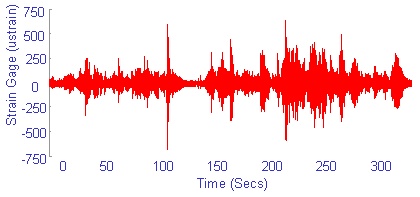
For loading situations like this it is better to enter stress ranges and means than maximum and minimum stresses.

Reasonable values for the minimum and R ratio include zero. This creates a problem in computing the standard deviation from the COV. Whenever either of these variables is zero, enter the standard deviation as the scale factor. Only Normal and Uniform distributions can be used with a zero value.
What is a reasonable variability for the loading variables? Naturally, every situation is different but based on past experience we can provide some general guidance. The relationship between standard deviation and COV for a LogNormal distribution is given below. Three standard deviations represents most (99.7%) of the data. Most of the data is within �16% of the median for a COV of 0.05 and within a factor of �2 for a COV of 0.25.
|
COVx |
Standard Deviation, lnx |
||
|
1 68.3% |
2 95.4% |
3 99.7% |
|
|
0.05 0.1 0.25 0.5 1 |
1.05 1.10 1.28 1.60 2.30 |
1.11 1.23 1.66 2.64 5.53 |
1.16 1.33 2.04 3.92 11.1 |
When comparing loading histories for determining the variability it is convenient to define an equivalent constant amplitude load from a variable amplitude history. That is, what constant amplitude load would produce the same fatigue life as the original loading history? The equivalent load, Feq for 106 constant amplitude cycles can be computed from the loading history as

where m is the slope of the SN curve. Typically this should be 4-6 for notched components. Two sets of data are plotted in the figure below. One set of data comes from test track driving of a motor home, the other comes from driving an auto in various cities during normal operation.
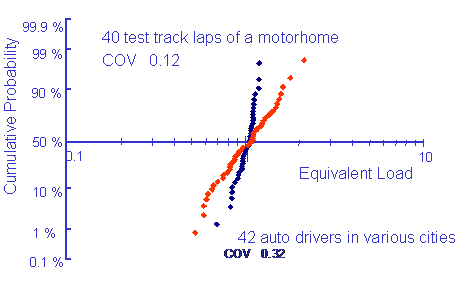
Here we are interested in the COV for the two sets of data. The test track data has a COV of 0.12 which is typical of controlled processes. Unsupervised city driving has much more variability with a COV of 0.3.
Selecting an appropriate variability will depend on how well controlled the loading will be. Many customers with widely varying usage characteristics will have a high variability.
Materials
The crack growth rate for a material is characterized by two material constants, an intercept C and a slope m. In addition, a threshold stress intensity, ΔKth may be defined.

Test data from 68 crack growth tests in an aluminum alloy (from Virkler, Hillberry and Goel, "The Statistical Nature of Fatigue Crack Propagation," Journal of Engineering Materials and Technology, Vol. 101,1979, 148-153) are shown below.
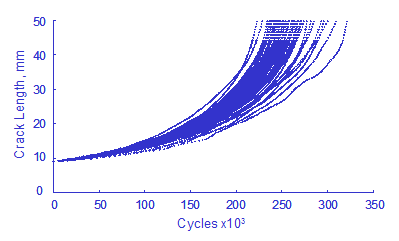
Crack growth rates for all tests and the distributions of the fatigue life are given below.
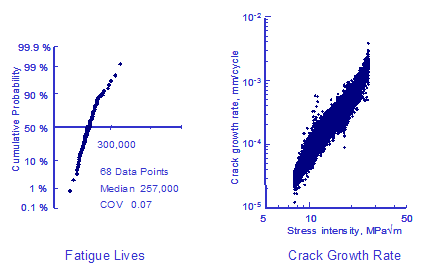
Material constants C and m were fit to each of the 68 tests to obtain an estimate of the variability.
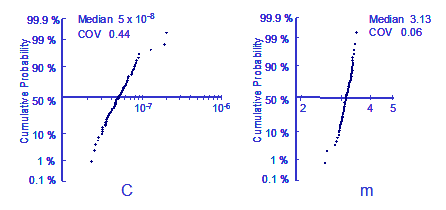

The Monte Carlo simulation will produce 100 sets of material constants. Results of using these constants to analyze the test data from which they were derived is shown below.
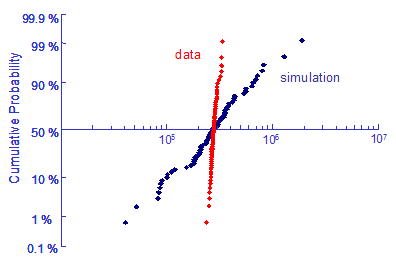
These results have ten times as much variability as the original test data. This is caused by a strong correlation between the material constants C and m.
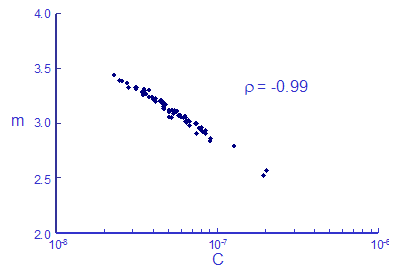
Adding the correlation coefficient to the analysis produces the following results.

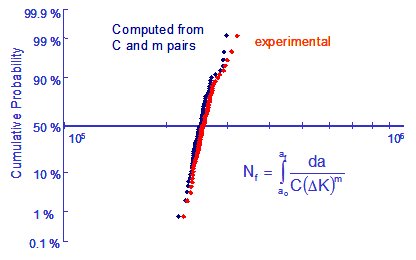
Slopes and intercepts for all fatigue data are usually highly correlated. Ignoring this correlation can give very misleading results in a simulation.
An alternate method to account for this correlation is to use a constant slope and put all of the variability into the intercept. For a constant slope, variability in fatigue lives will be directly related to variability in the material constant C. The best estimate of the COV for this data with a constant slope of 3.13 will be 0.07 not 0.44.
In the absence of test data, a COV = 0.1 would be a reasonable assumption for the crack growth intercept.
Stress Intensity Factor
Stress intensity factors do not have variability, they are computed from the governing differential equations. But they do have uncertainty and modeling errors. For example, the exact crack shape may be unknown and be approximated by a semicircle. Provisions have been made to add this uncertainty to the analysis. In this example, the values for F(a) would all be multiplied by a constant, randomly selected from a normal distribution with a mean of 1 and COV = 0.1 for each simulation.
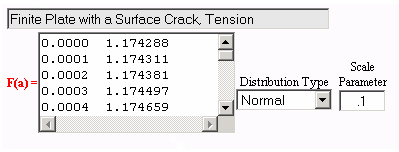
Variability in the final crack size should be directly related to the variability in the materials strength or fracture toughness. Data taken from Metals Handbook, 8th Edition, for variability in tensile strength is given below.
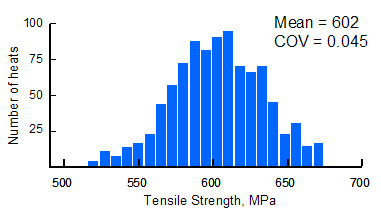
Fracture toughness usually has more variability than strength as shown below for the data takes from Kies et.al., "Fracture Testing of Weldments," ASTM STP 381, 1965.
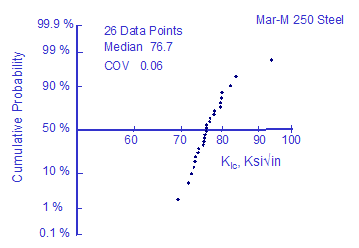
Final crack size has a small influence on the total fatigue life and the variability is smaller than the other variables so that in the absence of test data the final crack size may be taken as constant.
Initial crack size is one of the most important variables in determining the fatigue life. Variability in initial crack sizes will frequently be related to the variability in flaws that nucleate cracks such as inclusions and corrosion pits. Data for corrosion pits from Crawford et.al. "The EIFS Distribution for Anodized and Pre-corroded 7010-T7651 under Constant Amplitude Loading," Fatigue and Fracture of Engineering Materials and Structures, Vol. 28, No. 9 2005, shows that this variability is large.
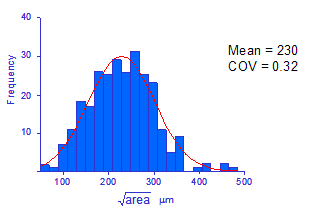
Corrosion pits are
irregularly shaped and the  is often used in place of the pit depth
or length.
is often used in place of the pit depth
or length.
The Simulation
One hundred trials are used in the simulation resulting in 100 calculated fatigue lives.
Output Results
Results of the simulation are given in graphical and tabular formats. First, the median life from the simulation is given. If the fatigue lives in the simulation are finite, a cumulative distribution of the calculated lives is presented in a LogNormal format. This chart is useful for determining probabilities of failure for other lives. Numerical values for this plot are available as the log of the life and number of standard deviations.
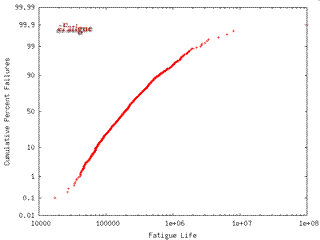
A probabilistic sensitivity analysis is performed to determine which variables have the highest contribution to the variability in fatigue lives. The probabilistic sensitivity factor αi is determined as:

The first term ∂Nf(X) / ∂Xi is the influence of the variable Xi on the fatigue life. This determines the most important variables affecting the fatigue life. It is multiplied by the standard deviation σi. A variable that may have a large influence on the fatigue life may have very little variability so that it will not contribute to the variability in fatigue lives. The elastic modulus is an example of such a variable. Results are plotted in a pie chart.
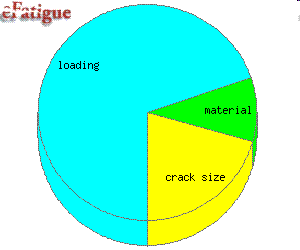
A table of the sensitivity factors is given. Mean and COV of the distributions used in the simulation are shown in the right side of the table.
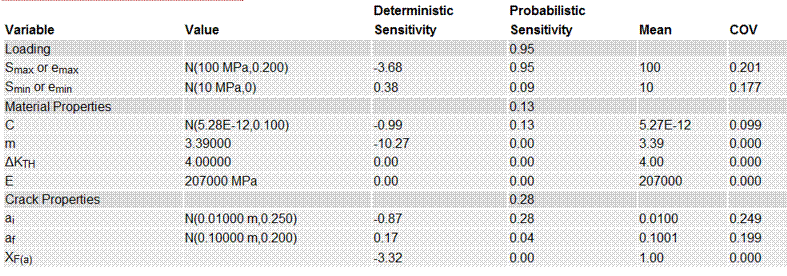
A table of results from the simulation is also given. The input data is displayed first. All calculated variables are also given.
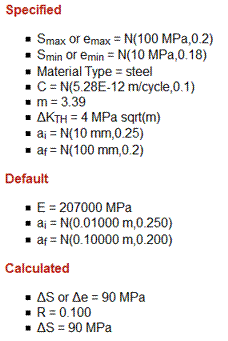
 日本語
日本語